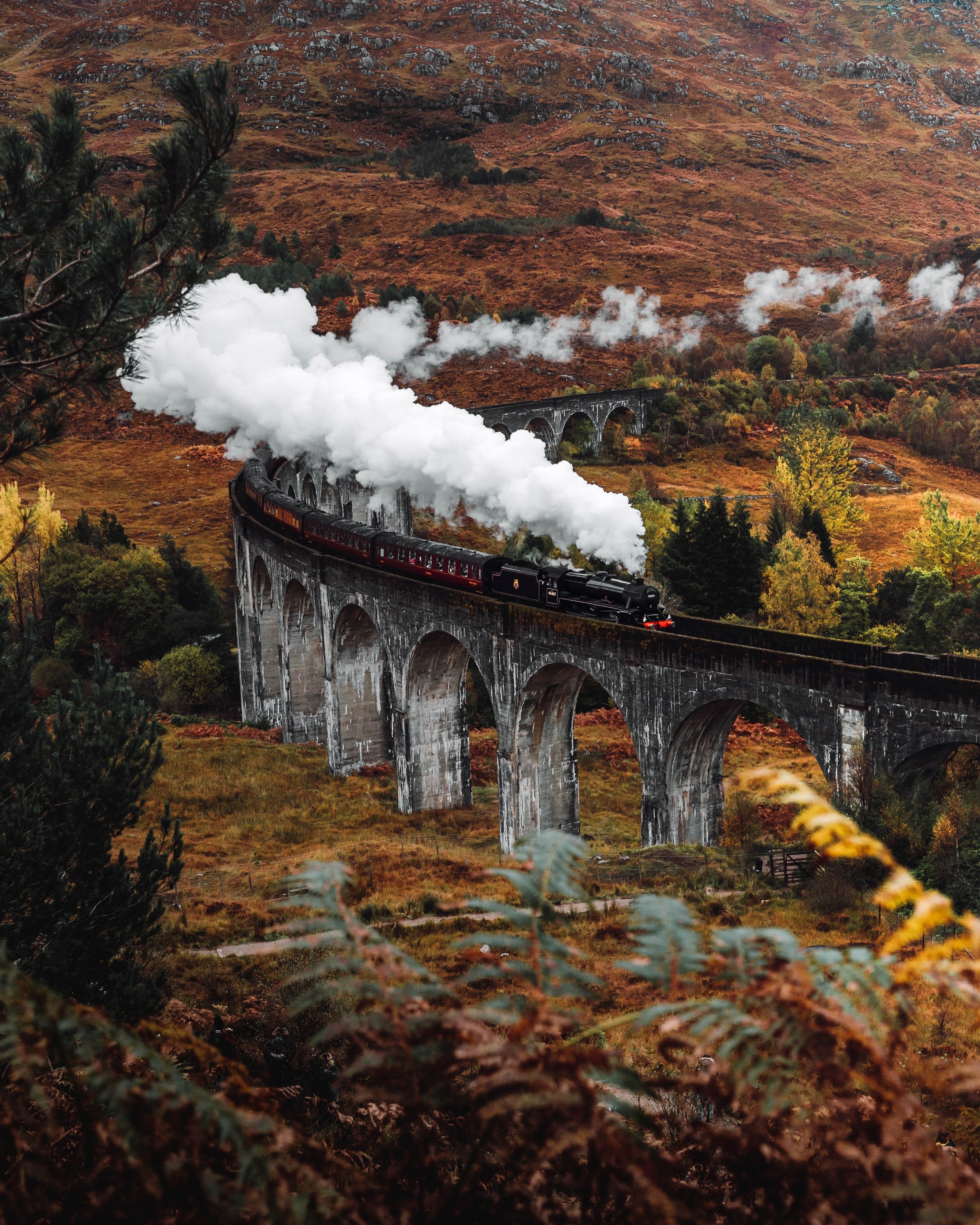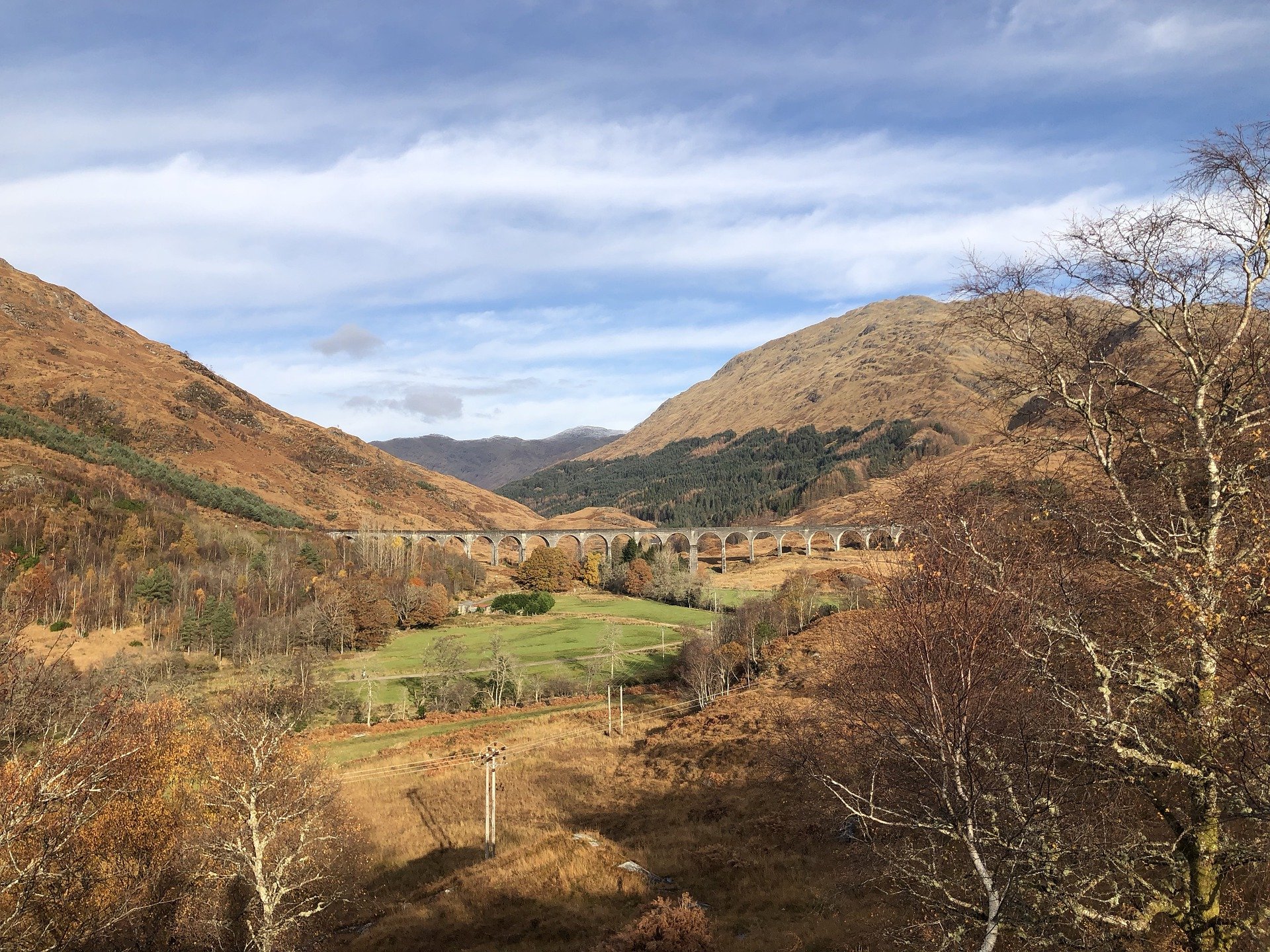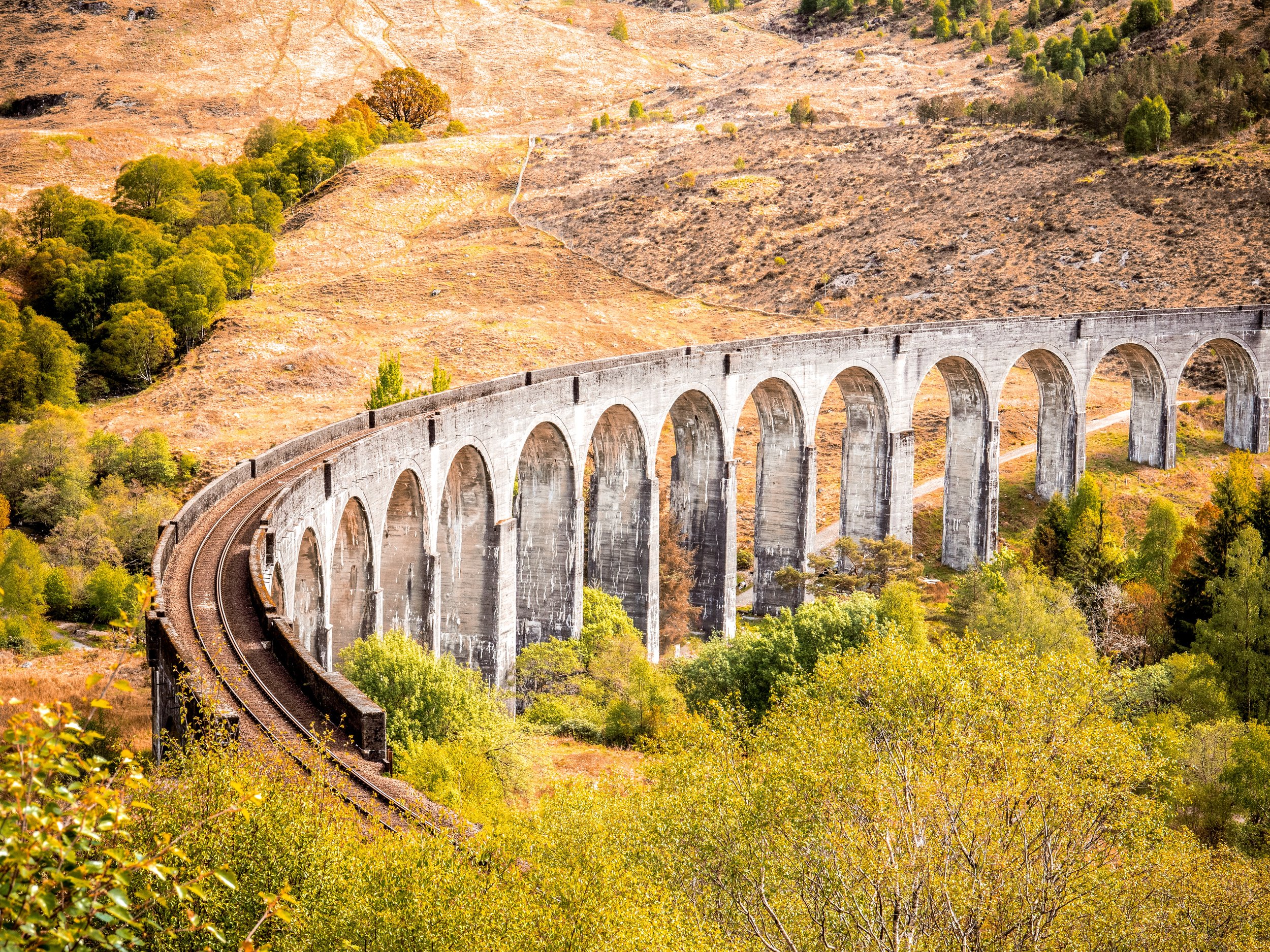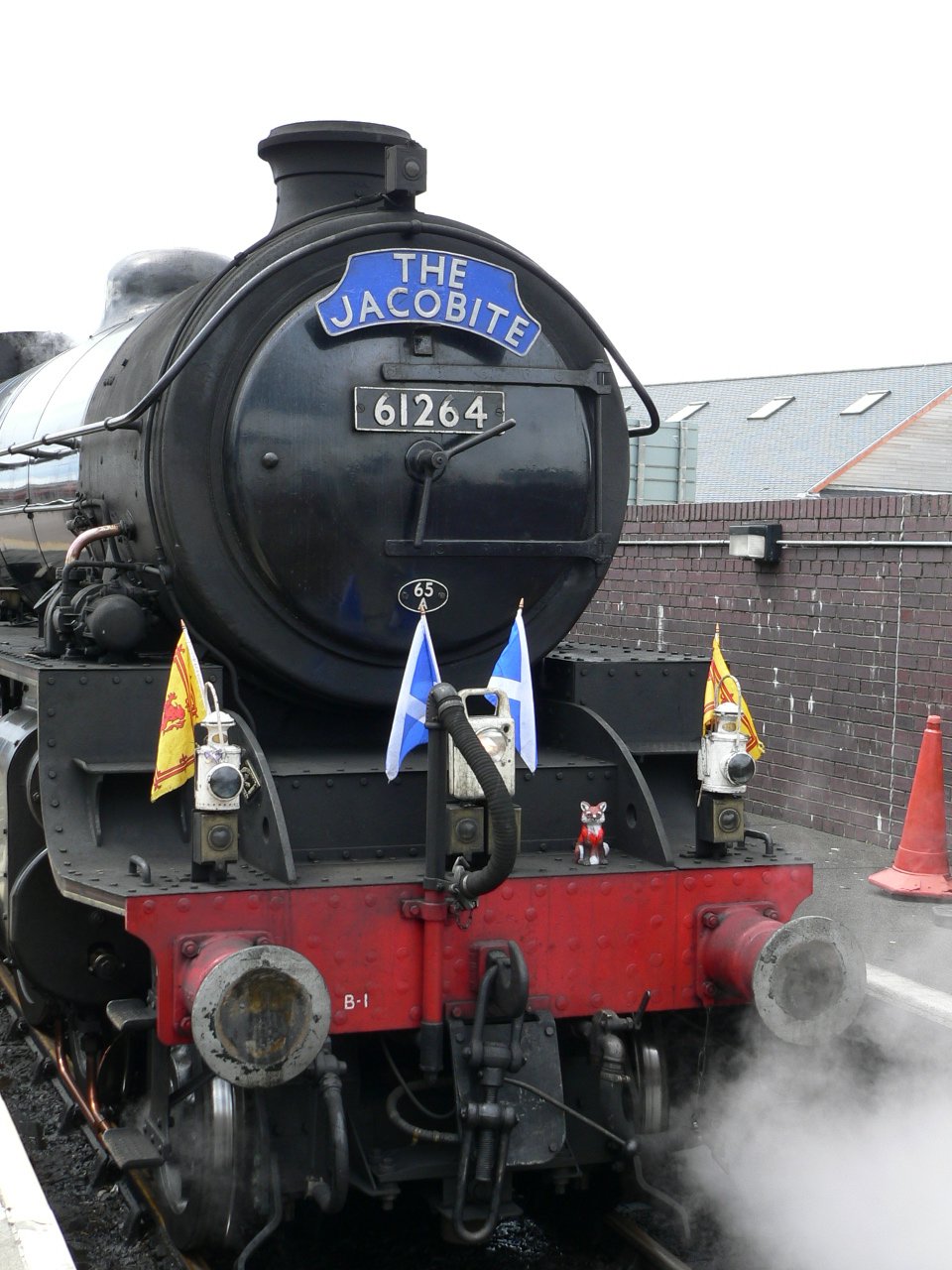Glenfinnan Viaduct
An amazing piece of architecture with quite a lot going for it
Let’s take in a sight to behold that involves a train chugging along a viaduct. You may not recognise the name, but you’ll know it when you see it.
The Viaduct
The Glenfinnan Viaduct is a bloody long viaduct at 380m. Made from concrete the bridge that only carries a single rail line is the longest to be found in Scotland. And it’s not exactly close to the ground either, allowing trains to cross the River Finnan 30m up in the air.
What holds the viaduct together are arches, and the one in Glenfinnan has 21 arches holding it up, but they aren’t tiny, they each spread out by 15m, so I hope you’re getting an idea as to the size of the thing.
But I may be getting ahead of myself, let’s make ourselves familiar with what a viaduct actually is. Basically, it’s a type of bridge that is supported by arches, piers or columns and generally are used by railways or roads. A viaduct is used most commonly to connect two points by passing over a valley or river, allowing the symmetry of the arches to feel really pleasing to the eye.
Now the Glenfinnan Viaduct was originally built to allow the West Highland Railway to cross a valley that holds the River Finnan with its main use being to move fish around.
While the engineers who oversaw the project were Simpson and Wilson of Glasgow, the actual building itself was completed by Robert McAlpine & Sons, along with about 3500 men of course.
And as we often forget that things were not always what they are now, there were many an injury that came about from the lack of concern for Workplace Health and Safety.
So the construction of the viaduct started in 1897 and was finished in 1898, but it wasn’t actually used until a couple years later when the railway line from Fort William to Mallaig was completed and opened in 1901.
Now the fact that the viaduct is built of concrete is thanks to Robert McAlpine. His innovative use of using concrete on mass gained him the nickname of ‘Concrete Bob’. And Bob would actually be the first one to use concrete on such a large scale, introducing the industry to the wonders of concrete and was even featured in The American Engineering News in 1899. Must have been big news at the time.
What’s so outstanding about the Viaduct being made from concrete, is that it was built from mass concrete, rather than reinforced concrete meaning that it did not need any metal reinforcement. It’s pure concrete. This makes the concrete very very strong especially when being compressed, but its tension is weaker, so less cracks.
And it’s this method of pouring concrete, that was first used in Britain when constructing the viaduct, that has allowed it to be in such great shape over 100 years later.
And the bridge isn’t just in a straight line either, it’s built on a curve which means that if you’re on the train you can look out the window and see the other half of the train chugging along, and with that gorgeous Highland scenery what a sight to behold.
Although before construction even got started, not everyone was a fan.
A great outcry was raised at the desecration of so historic and beautiful a spot…by so ugly and commonplace a structure as a railway viaduct.
And made out of concrete too. What were they thinking?
How it’s used
As we already are aware, the Glenfinnan Viaduct holds the railway that will at some point find itself at Glenfinnan Station. And some of the pretty cool trains that use the Viaduct as a crossing include the Belmond Royal Scotsman and the Jacobite Steam Train, which you might know as the Hogwarts Express, used by Harry Potter and his friends to get to their magical school. If you look carefully, you can even see the Glenfinnan Viaduct in some of the films.
It's actually thanks to Harry Potter that the Viaduct is as popular as it is. Even though the structure is pretty important civil engineering wise, and those surroundings have been around since always, it is the Viaduct’s starring role that has made it popular with tourists.
As part of the West Highland Line that connects Fort William to Mallaig, the Viaduct was pretty important for the fish trade in the area, and I suppose the local economy in general, especially after those pesky Highland Clearances had swept through.
These days the line doesn’t carry as many fish as it does passengers on four passenger trains that travel the line every day. And it’s not just locals getting about either, tourists use the line for those magical scenic views. So it’s almost no surprise to hear it described as
the greatest railway journey in the world.
And it’s not just the viaduct that you might encounter on your railway journey. You’ll also see some pretty awesome sights like the highest mountain in Britain that goes by Ben Nevis, Britain’s most westerly railway station that still sits on the mainland, Arisaig; Britain’s deepest freshwater loch, Loch Morar; Britain’s shortest river, River Morar; and Europe’s deepest seawater loch, Loch Nevis. Britain sure has a lot of things to show off.
The Royal Scotsman
So what’s it like to cross the Viaduct in a train? Well as a tourist you’ll probably be looking at one of two options.
The Royal Scotsman is so grand that as soon as you step onto the train you feel as if you’re entered another time. And it’s not all about the train either, the daily excursions can be very exciting with tastings at distilleries and even clay pigeon shooting. There is dinner by candlelight and live music all aboard the train. I can see why they call this train experience:
at once leisurely and luxurious, intimate and eye-opening.
So the Belmond Royal Scotsman has been running on tracks since 1985 and you could even call it a palace on wheels, I mean you even get the red carpet when boarding accompanied by a Highland piper and champagne, what more do you need? Now it really is an intimate experience with only 36 guests at any one time and 12 staff, you can rest assured that your whims will be tended to.
So back in 1985, two entrepreneurs had leased a couple of coaches, and set about running them for passengers. The service proved so popular that a new set of Pullman cars were specially renovated as Royal Scotsman carriages in 1990, and these included the sleeping cars, dining-car and the lounge-observation car.
And they did not spare any expense on the renovation, with lacquer-polished wooden-panels installed and fabrics that mirrored an Edwardian country-house.
In 2005, the Royal Scotsman was bought by Orient Express Trains and now makes up part of their world-class luxury line-up. But the Royal Scotsman didn’t always go by ‘the Royal Scotsman’, the train didn’t actually get that name until 2007. Although you do have to admit that calling a train ‘the Royal Scotsman’ sure does make you expect extreme luxury, and surely the addition of a spa carriage says peak luxury.
Now the car that I think would be my favourite if I were ever lucky enough to travel on such a train would be the observation car. This carriage is all kitted out with comfortable sofas and armchairs to sit back, relax and enjoy the gorgeous scenery as it goes past. But what’s really cool is the open-air observation platform that’s available for you to step out onto. And of course you can’t forget the live music that’s available each evening to set the scene.
You know the train is luxurious when you find out it has two dining cars, Raven has large tables that can sit between 6 and 8, and Victory is laid out in a more conventional style with tables for 2 to 4. In both you can expect mahogany panelling and gorgeous fabrics to make it really plush. Now the food you get on this train isn’t like the food you get on a plane in economy. All the food is cooked on board by the train’s chef, so you know you’re in for a good meal when you sit down. But you’ll have to remember to dress the part, because at least one dinner on each tour is ‘formal’.
As you can expect, each suite is fully kitted out with all the amenities you could want. Dressing tables, full length wardrobes, ensuites with showers, hairdryers, bathrobes, heating, a foam pillow and a feather duvet. Almost makes you wonder why you would leave to explore the rest of the train.
While there are 14 twin cabins, 2 double cabins and 4 single State Cabins, it is important to note that at night the train isn’t moving. It’s actually stabled in a siding or at a station, which means that you always get a good sleep without all the ricketiness of a moving train.
There are several itineraries that you can choose from on your Belmond Royal Scotsman experience, and you really can’t go wrong in your choices. Ranging from one to seven night journeys all of them feature excursions out to castles, distilleries and sporting adventures. Just have a flick through the itineraries available on their website and you’ll know what I mean. Whichever itinerary you decide on, you’ll be starting your journey in Edinburgh before exploring the already established gorgeous Scottish Highlands. Now while it is quite on the expensive side, the price does include everything, all meals and drinks, your accommodation on the train and any off-train excursions you partake in. So what are you waiting for? Get yourself over to Edinburgh Waverley Station’s first class lounge where you’ll wait for the Drum Major to pipe you aboard one of the most luxurious trains in the world.
The Jacobite Steam Train
The Jacobite Steam Train has been chugging the rails about the same amount of time as the Royal Scotsman. Starting out life known as the West Highlander in 1984, the train journey proved so successful that it was later given the name The Lochaber. And then when British Rail was privatised and became West Coast Railways in 1995, the train was rebranded to The Jacobite Steam Train, as the line it ran has connections to the Jacobite movement.
Now you might be thinking, how is this train different from the first one we looked at. And while you might not know this train by its name, you’ll probably recognise its image, as it’s the same one used in the Harry Potter films, playing the character of the Hogwarts Express beautifully.
While it’s always been a fan with tourists, after Harry Potter swept the world, its popularity really skyrocketed. Running part of the West Highland line in Scotland, the route starts at Fort William and ends up 65 km later at Mallaig.
The Jacobite Steam Train is a daily service, with the train departing Fort William at 10.15 and arriving at Mallaig by 12.25, then it’s a couple hours’ break before heading back at 2.10 and getting to Fort William by 4pm. And of course for many of those tourists, the highlight is crossing the brilliant Glenfinnan Viaduct, where of course the bend allows you to see the other end of the train for those awesome pictures. In 2011, the journey on the Jacobite became so popular that a second daily service was added during the busy season that runs between June to August.
And while the interior of the Jacobite may not be what the Royal Scotsman is, you do have to remember you’re not sleeping on the Jacobite. But the first and standard class coaches are still top notch. And really what you want is a clean window to see the Scottish scenery and you’re all set. But make sure to check out the timetable before setting off so that you don’t miss the train.
Glenfinnan and surrounds
Even though most tourists come for the Viaduct, Glenfinnan itself isn’t a one-trick pony and there’s actually a couple other things you should add to the list if you’re going to be in the area.
You’ll find the town or Hamlet of Glenfinnan at the top of Loch Shiel. So immediately you know you’re in for some good Scottish Highland scenery all round.
The Glenfinnan Monument was erected in commemoration of the Jacobite Rising in 1815. It was actually in Glenfinnan in 1745 that the Jacobite Rising first took off when Bonnie Prince Charlie chose the shores of Loch Shiel to raise his standard. So it seems the Viaduct isn’t the areas only historical claim to fame.
But of course we know that the Jacobite Rising didn’t exactly go the way they wanted, and so it was Alexander Macdonald who put up the 18m tall monument. Since then it’s passed into the care of the National Trust of Scotland and is now a full time tourist attraction.
And if you’re after some more interesting historical information then you can’t go past the Glenfinnan Visitor Centre, it even has a café so you can grab a cup of tea and a slice of cake while you wait before you head off to a spot to view the train crossing the Glenfinnan Viaduct.
If you ask kindly, you may even be offered a guided tour to the top of the Glenfinnan Monument. There’s modern exhibitions and displays and even an audio programme about what Bonnie Prince Charlie did while he was in the area before his defeat at the Battle of Culloden. Check out our episode on the Battle of Culloden if you haven’t already.
And of course you can’t pop in without poking your head into the gift shop for a souvenir.
Best spots for a view
Now that the Viaduct is pretty famous there are quite a few people who travel from around the world to find a spot to watch a train cross a really high bridge with Scottish mountains in the background. What might surprise you is that there isn’t any one spot that’s been deemed as the viewpoint for the Glenfinnan Viaduct. Really if you find a spot with a view of the Viaduct you’re in a good place. In fact, there’s actually a couple of good spots to choose from.
So if you want to see a train cross the bridge you’ll need to be up to date on the train timetables as they have a habit of changing season to season. Throughout summer, so June to September for the many of us not in the Northern Hemisphere, there are usually two services that cross the bridge, but in the other seasons there’s often only one a day so make sure to check the schedule before you head out if you don’t want to miss it.
While there are a number of carparks near the good viewing spots, there’s only so much space, so it’s recommended you get there about half an hour before the train’s due to cross so that you’re not stressing about where the park.
The first viewpoint and often the most popular is about halfway up a hill with a path so you can’t miss it. But some have said that if you go further up the path you can often find a better spot with fewer people milling about so it’s recommended that you explore a little bit before settling on a spot.
And if you don’t particularly want to walk too far, you can always see the viaduct from next to the Visitor Centre, but it’s not the best angle for those cool photos.
And don’t worry too much about not having enough time to prepare the camera, you’ll often be able to see the smoke billowing from around the corner of the mountain before the train comes into view, and the trains will also slow down as they cross the viaduct so that everyone has a good amount of time to take the perfect photo.
-
-
Glenfinnan Viaduct - Atlas Obscura
The Glenfinnan Viaduct Viewpoint - Average Lives
Glenfinnan Viaduct - Britain Express
Glenfinnan Viaduct - Scottish Places
Glenfinnan Viaduct - Highland Titles
The Construction of Glenfinnan Viaduct - Sir Robert McAlpine
Glenfinnan Viaduct world’s first mass concrete structure - Understanding Cement
Disclosure: As an affiliate marketer, we may receive a commission on products that you purchase through clicking on links within this website.



















